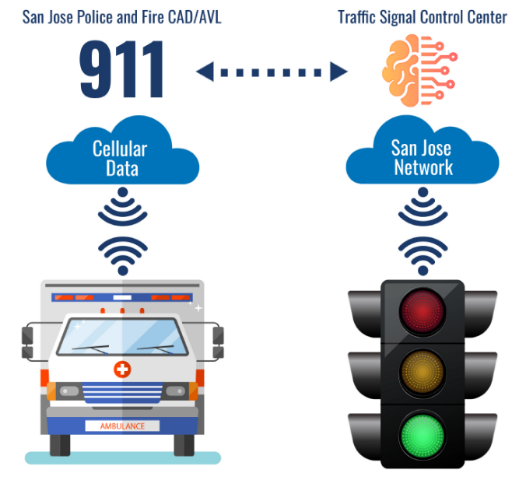
Giving First Responders the Green Light
Emergency Vehicle Preemption Speeds TIM Response
About 6 million police-reported vehicle crashes occur every year in the United States, impacting safety and system operations. Each crash places responders and motorists at risk of secondary crashes while causing delays that impact travel and freight movement. Next-Generation Traffic Incident Management (NextGen TIM) technologies help responders clear the road faster, reducing their exposure to traffic and restoring normal traffic flow sooner.
During Every Day Counts round 7 (EDC-7), NextGen TIM is promoting life-saving innovations such as advance warning technologies, debris removal systems, emergency vehicle lighting and markings, unmanned aerial systems for TIM, and advancements in emergency vehicle preemption (EVP).
EVP improves incident responder safety and response time by changing traffic signals to green for an approaching response vehicle. Upon receiving a visual, audible, radio, or global positioning system (GPS) signal that a vehicle in emergency response mode is approaching, signal systems and controllers preempt the timing plans and give preference to the appropriate intersection approach. EVP has been around for several years but is gaining attention with new technologies that are making it more reliable, more cost effective, and less cumbersome to manage.
Different EVP Approaches
More than half the 3,332 signalized intersections in the metropolitan Phoenix, AZ, area are equipped with EVP. These systems use an equipment-based model where individual response vehicles and intersection signal controls are furnished with hardware to change signals on approach. The Maricopa Association of Governments (MAG) coordinates this regional EVP approach with more than 21 cities and dozens of public safety agencies in the Phoenix area. MAG agencies have embraced EVP and work together to improve compatibility and share resources. They also recently completed a pilot study of a GPS-based EVP system with favorable results. A GPS-based system represents the next innovative evolution of EVP that will enable a quicker response to incidents.

San Jose’s emergency vehicle preemption system pinpoints the location of responding vehicles and controls the signals remotely.
Credit: Enforcement Engineering, Inc.The city of San Jose, CA, has made significant strides in reducing response time through a centralized, dynamic, GPS-based approach to EVP. Instead of relying on equipment installed on each responder vehicle and at each of its 967 signalized intersections, San Jose’s system uses GPS to leverage its advanced traffic management system, public safety computer-aided dispatch (CAD), and automated vehicle location information for police and fire vehicles across the city.
Through CAD integration, the advanced traffic management system knows when high-priority emergency calls are dispatched and which response vehicles are assigned. The automated vehicle location (AVL) pinpoints the real-time location of responding vehicles, and traffic signals are remotely controlled using a central traffic control system with controller firmware.
San Jose’s EVP system allows the response vehicle to select any route to the emergency scene. Rather than define the route and trigger EVP at appropriate signals along the way, the system creates a geofence around the signalized intersection, detects the approaching emergency vehicle, and provides the appropriate green signal time.
“The centralized EVP approach lowered deployment and operating costs, created ease and consistency of operation, and simplified scalability,” said Ho Nguyen, Intelligent Transportation System manager for the city of San Jose. “Intersection delay was reduced from 7 seconds per intersection to less than 1 second.” San Jose Fire Chief Robert Sapien, Jr. noted that they are shaving nearly one-half minute off their average response time because they can now get through intersections faster.
Watch this video to hear about the life-saving technologies NextGen TIM is promoting during EDC-7.
Credit: FHWAEVP Benefits
EVP not only speeds response time, it makes emergency response safer. According to Chief Sapien, over the past 5 years, the number of fire department vehicles involved in traffic crashes has been cut more than in half. In addition to training and agency safety initiatives, EVP is credited as part of this success.
EVP and other NextGen TIM technologies are also an important part of the National Roadway Safety Strategy because they address post-crash care in the Safe System Approach.
“TIM affects every one of us, every day,” said NextGen TIM team co-lead Paul Jodoin. “We look forward to working with agencies during EDC-7 to increase implementation of EVP and other life-saving TIM technologies.”
—MORE INFORMATION
Visit the FHWA Traffic Incident Management webpage.
Subscribe to the NextGen TIM: Technology for Saving Lives e-bulletin.
Contact Paul Jodoin, Jim Austrich, or Joe Tebo of the FHWA Office of Operations for NextGen TIM information, technical assistance, and training.
Disclaimer: The U.S. Government does not endorse products or manufacturers. Trademarks or manufacturers’ names appear in this document only because they are considered essential to the objective of the document. They are included for informational purposes only and are not intended to reflect a preference, approval, or endorsement of any one product or entity.
Except for the statutes and regulations cited, the contents of this document do not have the force and effect of law and are not meant to bind the States or the public in any way. This document is intended only to provide information regarding existing requirements under the law or agency policies.
Recommended Citation: U.S. Department of Transportation, Federal Highway Administration - Washington, DC (2023) Innovator Newsletter, November/December 2023, Volume 17 (99). https://doi.org/10.21949/1521764



